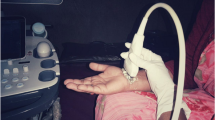Abstract
Objectives
The aim of the present study was to quantify the stiffness of the median nerve (MN) at the carpal tunnel inlet by acoustic radiation force impulse (ARFI) elastography and to evaluate whether ARFI can be used in diagnosis and staging of carpal tunnel syndrome (CTS).
Methods
Sonographic examinations of 96 wrists in 50 patients were included in the study. The cross-sectional area and stiffness of the MN were quantitatively measured by B-mode ultrasonography (USG) and ARFI. The findings of CTS were assigned to four groups: (I) normal (n = 21), (II) mild (n = 39), (III) moderate (n = 38), and (IV) severe (n = 19). The differences between CTS patients and controls and the differences in electrodiagnostic tests among subgroups were statistically compared. ROC analysis was performed to determine the cut-off values between subgroups.
Results
Bilateral CTS was present in 46 patients (92 wrists) and unilateral CTS in four patients. Of the 96 nerves in the 50 symptomatic “idiopathic CTS” patients (48 women, 2 men; mean age 45.9 years, range 23–73 years), 39 (40.4%) were mild, 38 (39.8%) were moderate, and 19 (19.8%) were severely affected. When compared to controls, MN stiffness was significantly higher in the CTS group (P < 0.001); furthermore, it was higher in the severe or extreme severity group than the mild or moderate severity group (P < 0.001). A 3.250 m/s cut-off value on ARFI revealed sensitivity, specificity, positive predictive value, negative predictive value, and accuracy of 81, 82, 95.1, 50, and 82%, respectively.
Conclusion
The MN stiffness measured by ARFI elastography is significantly higher in patients with CTS then in controls. ARFI elastography appears to be a highly efficient imaging modality for the diagnosis and staging of these patients.




Similar content being viewed by others
References
Bianchi S, Martinoli C, Sureda D, et al. Ultrasound of the hand. Eur J Ultrasound. 2001;14:29–34.
Peetrons PA, Derbali W. Carpal tunnel syndrome. Semin Musculoskelet Radiol. 2013;17:28–33.
Andreisek G, Crook DW, Burg D, et al. Peripheral neuropathies of the median, radial, and ulnar nerves: MR imaging features. Radiographics. 2006;26:1267–87.
Barcelo C, Faruch M, Lapegue F, et al. 3-T MRI with diffusion tensor imaging and tractography of the median nerve. Eur Radiol. 2013;23:3124–30.
Tasdelen N, Gurses B, Kilickesmez O, et al. Diffusion tensor imaging in carpal tunnel syndrome. Diagn Interv Radiol. 2012;18:60–6.
Wong SM, Griffith JF, Hui AC, et al. Carpal tunnel syndrome: diagnostic usefulness of sonography. Radiology. 2004;232:93–9.
Bamber J, Cosgrove D, Dietrich CF, et al. EFSUMB guidelines and recommendations on the clinical use of ultrasound elastography. Part 1: basic principles and technology. Ultraschall Med. 2013;34:169–84.
Botanlioglu H, Kantarci F, Kaynak G, et al. Shear wave elastography properties of vastus lateralis and vastus medialis obliquus muscles in normal subjects and female patients with patellofemoral pain syndrome. Skelet Radiol. 2013;42:659–66.
Park GY, Kim SK, Park JH. Median nerve injury after carpal tunnel injection serially followed by ultrasonographic, sonoelastographic, and electrodiagnostic studies. Am J Phys Med Rehabil. 2011;90:336–41.
Orman G, Ozben S, Huseyinoglu N, et al. Ultrasound elastographic evaluation in the diagnosis of carpal tunnel syndrome: initial findings. Ultrasound Med Biol. 2013;39:1184–9.
Kantarci F, Ustabasioglu FE, Delil S, et al. Median nerve stiffness measurement by shear wave elastography: a potential sonographic method in the diagnosis of carpal tunnel syndrome. Eur Radiol. 2014;24:434–40.
Padua L, Padua R, Lo Monaco M, et al. Multiperspective assessment of carpal tunnel syndrome: a multicenter study. Italian CTS Study Group. Neurology. 1999;53:1654–9.
Jablecki CK, Andary MT, Floeter MK, et al. Practice parameter for electrodiagnostic studies in carpal tunnel syndrome: summary statement. American Association of Electrodiagnostic Medicine, American Academy of Neurology, American Academy of Physical Medicine and Rehabilitation. Muscle Nerve. 1993;16:1390–1.
Padua L, LoMonaco M, Gregori B, et al. Neurophysiological classification and sensitivity in 500 carpal tunnel syndrome hands. Acta Neurol Scand. 1997;96:211–7.
Martinoli C, Bianchi S, Gandolfo N, et al. US of nerve entrapments in osteofibrous tunnels of the upper and lower limbs. Radiographics. 2000;20:S199–213 (discussion S-7).
Coppieters MW, Schmid AB, Kubler PA, et al. Description, reliability and validity of a novel method to measure carpal tunnel pressure in patients with carpal tunnel syndrome. Man Ther. 2012;17:589–92.
Wang Y, Qiang B, Zhang X, et al. A non-invasive technique for estimating carpal tunnel pressure by measuring shear wave speed in tendon: a feasibility study. J Biomech. 2012;45:2927–30.
Rempel D, Dahlin L, Lundborg G. Pathophysiology of nerve compression syndromes: response of peripheral nerves to loading. J Bone Joint Surg Am. 1999;81:1600–10.
Xin H, Hu HY, Liu B, et al. Ultrasound elastographic evaluation of the median nerve in hemodialysis with carpal tunnel syndrome. J Med Ultrason. 2001;2017:123–31.
Kang S, Kwon HK, Kim KH, et al. Ultrasonography of median nerve and electrophysiologic severity in carpal tunnel syndrome. Ann Rehabil Med. 2012;36:72–9.
Author information
Authors and Affiliations
Corresponding author
Ethics declarations
Ethical statements
This study was approved by the Yuzuncu Yil University ethics committee. Written informed consent was obtained from all individuals included in the study. This manuscript has not been published and is not under consideration for publication elsewhere. There is no overlap of our present work with any previously published studies.
Conflict of interest
The authors declare that they have no conflicts of interest or industry support to disclose.
About this article
Cite this article
Arslan, H., Yavuz, A., İlgen, F. et al. The efficiency of acoustic radiation force impulse (ARFI) elastography in the diagnosis and staging of carpal tunnel syndrome. J Med Ultrasonics 45, 453–459 (2018). https://doi.org/10.1007/s10396-017-0857-7
Received:
Accepted:
Published:
Issue Date:
DOI: https://doi.org/10.1007/s10396-017-0857-7




